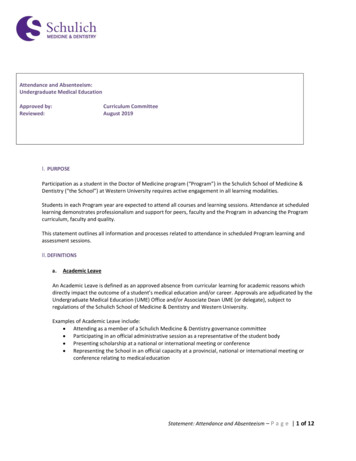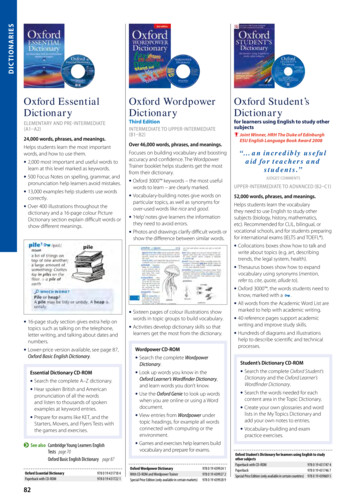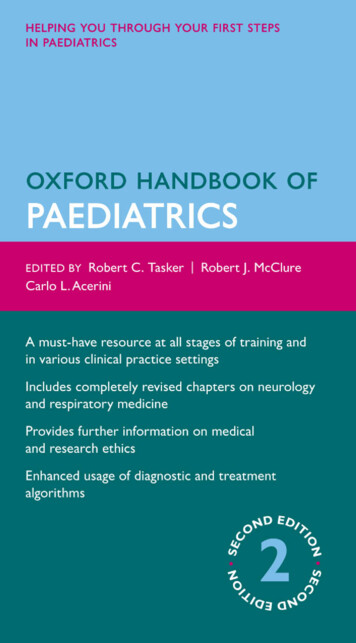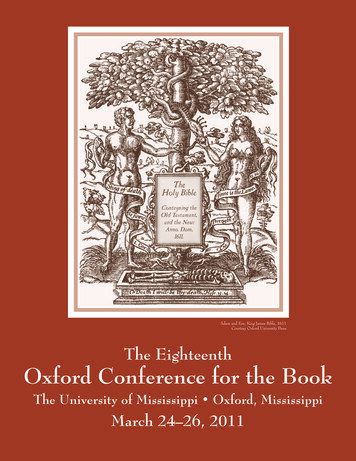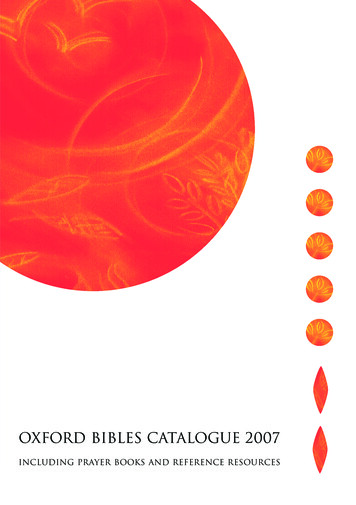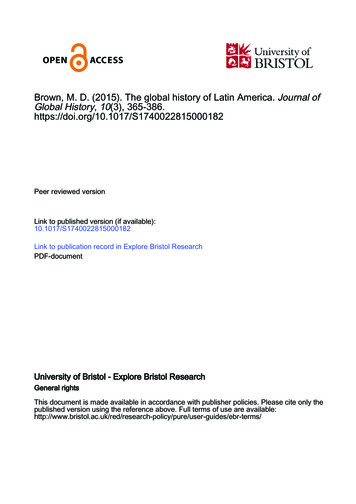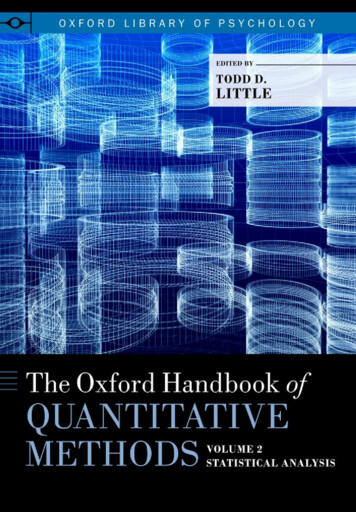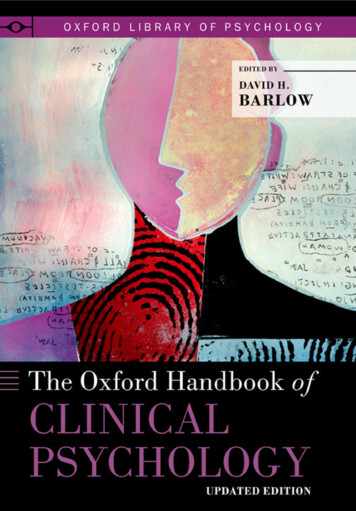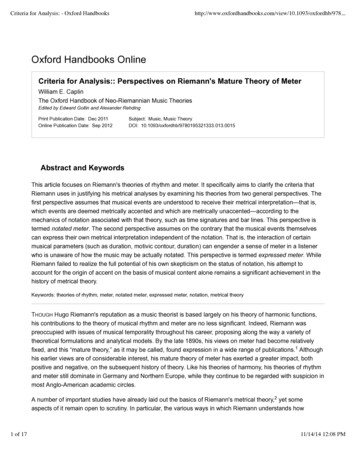
Transcription
Criteria for Analysis: - Oxford 93/oxfordhb/978.Oxford Handbooks OnlineCriteria for Analysis:: Perspectives on Riemann's Mature Theory of MeterWilliam E. CaplinThe Oxford Handbook of Neo-Riemannian Music TheoriesEdited by Edward Gollin and Alexander RehdingPrint Publication Date: Dec 2011Online Publication Date: Sep 2012Subject: Music, Music TheoryDOI: 10.1093/oxfordhb/9780195321333.013.0015Abstract and KeywordsThis article focuses on Riemann's theories of rhythm and meter. It specifically aims to clarify the criteria thatRiemann uses in justifying his metrical analyses by examining his theories from two general perspectives. Thefirst perspective assumes that musical events are understood to receive their metrical interpretation—that is,which events are deemed metrically accented and which are metrically unaccented—according to themechanics of notation associated with that theory, such as time signatures and bar lines. This perspective istermed notated meter. The second perspective assumes on the contrary that the musical events themselvescan express their own metrical interpretation independent of the notation. That is, the interaction of certainmusical parameters (such as duration, motivic contour, duration) can engender a sense of meter in a listenerwho is unaware of how the music may be actually notated. This perspective is termed expressed meter. WhileRiemann failed to realize the full potential of his own skepticism on the status of notation, his attempt toaccount for the origin of accent on the basis of musical content alone remains a significant achievement in thehistory of metrical theory.Keywords: theories of rhythm, meter, notated meter, expressed meter, notation, metrical theoryTHOUGH Hugo Riemann's reputation as a music theorist is based largely on his theory of harmonic functions,his contributions to the theory of musical rhythm and meter are no less significant. Indeed, Riemann waspreoccupied with issues of musical temporality throughout his career, proposing along the way a variety oftheoretical formulations and analytical models. By the late 1890s, his views on meter had become relativelyfixed, and this “mature theory,” as it may be called, found expression in a wide range of publications.1 Althoughhis earlier views are of considerable interest, his mature theory of meter has exerted a greater impact, bothpositive and negative, on the subsequent history of theory. Like his theories of harmony, his theories of rhythmand meter still dominate in Germany and Northern Europe, while they continue to be regarded with suspicion inmost Anglo-American academic circles.A number of important studies have already laid out the basics of Riemann's metrical theory,2 yet someaspects of it remain open to scrutiny. In particular, the various ways in which Riemann understands how1 of 1711/14/14 12:08 PM
Criteria for Analysis: - Oxford 93/oxfordhb/978.metrical accentuation comes into being—whether it ensues directly from a preconceived model or whether itarises naturally out of the musical materials themselves—call for further study and interpretation. The presentessay seeks to clarify the criteria that Riemann uses to justify his metrical analyses by examining his theoriesfrom two general (p. 420) perspectives, ones from which any theory of meter can be formulated and appliedanalytically. From the first perspective, musical events are understood to receive their metricalinterpretation—that is, which events are deemed metrically accented (or strong) and which are metricallyunaccented (or weak)—according to the mechanics of notation associated with that theory, such as timesignatures and bar lines. Such a perspective can thus be termed a notated meter. A second perspectiveassumes, on the contrary, that the musical events themselves can express, so to speak, their own metricalinterpretation independent of the notation. That is, the interaction of certain musical parameters (such as pitch,duration, motivic contour) can engender a sense of the meter in a listener who is unaware of how the musicmay actually be notated, a situation that arises in many listening contexts. This perspective can be termedexpressed meter.At first consideration, Riemann's mature theory of meter, as represented at various times in his writings by thekinds of models shown in example 15.1 seems to function as a notated meter. Though different in format, fouressential features are common to each model. First, they present a hierarchical organization comprising fourlevels of structure—the level of the beat, the measure, the two-measure half phrase, and the four-measurephrase. By proposing a metrical interpretation for levels residing beyond the confines of the notated measure,indeed as high as a full eight-measure period, Riemann brings to a culmination the general nineteenth-centurytendency to view higher level rhythm as hypermetrical.3 Second, each level of this temporal hierarchy containsa series of regularly alternating accented and unaccented events. In this respect, Riemann's mature modelconforms to traditional approaches. Third, every rhythmic grouping of the events at each level is understood tobe “end-accented.” Unlike most earlier views, in which the accent is regarded as the beginning of a structuralunit (such as the measure), Riemann dogmatically holds that in all cases, and at every level of metricalorganization, the accented event is an end, a goal of musical motion. His model of musical meter has thereforebeen appropriately termed an Auftakttheorie (“theory of upbeat”). The aesthetic principle underlying this view isthat of “active hearing.”4 According to Riemann, we do not passively relate an unaccent to the accent thatprecedes it, but rather we actively direct our attention to the accent that follows it; we hear toward a goal, notaway from a starting point. Fourth, and finally, Riemann establishes his model as preexisting, as a theoretical apriori. The musical content receives its metrical interpretation from the model, which compensates for the lackof notational symbols for meter at levels above that of the measure. In short, the model can be considered akind of notated meter, such that the model itself provides the metrical interpretation for higher levels ofstructure.Click to view largerEx. 15.1a. From Elementar-Schulbuch, 180.2 of 17A closer examination reveals, however, that Riemann'smetrical theory can also be understood from anexpressed-meter perspective. Indeed, Carl Dahlhaus hasargued that Riemann's metrical analyses are grounded inspecific pitch relationships: “The harmonic criteria uponwhich Riemann bases the distinction between heavy andlight measures are never explicitly articulated or grounded byhim. They can, however, be reconstructed through ananalysis of his analyses. Riemann is still a systematizer, even11/14/14 12:08 PM
Criteria for Analysis: - Oxford HandbooksClick to view largerEx. 15.1b. From “Neue Beiträge zu einer Lehre vonden Tonvorstellungen,” 11.Click to view largerEx. 15.1c. From Große Kompositionslehre, 093/oxfordhb/978.when he is silent.”5 Though Dahlhaus is surely correct inidentifying principles of (p. 421) harmony that lie at the root ofRiemannian metrics, an investigation of Riemann's writingsreveals that he is far from silent on the criteria he uses foranalyses. In a number of remarks scattered throughout hismature writings, he justifies his metrical readings byappealing to the actual content of the music underconsideration. In doing so, he invokes five principles: (1)Harmoniewirkung (“effect of harmony”), (2) motivic imitation,(3) durational accent, (4) tonal accent, and (5) Schlußwirkung(“effect of cadence”).6 In an effort to interpret Riemann's ownaccount of his system, I examine each of these principles inorder to consider the extent to which they reflect an (p. 422)expressed-meter perspective. I further attempt to determinewhether theorists would likely hold these criteria as valid andpersuasive today.HarmoniewirkungThe first extensive treatment of Riemann's main principle of harmonic-metric interaction appears in the firstvolume of Grundriß der Kompositionslehre: “First of all, it can be generally stated that the more accented anote is, the more one expects it to have a change of harmony; in other words, the moments of time upon whichnew harmonies preferably enter are the strong points of the motive, group [of motives], and phrases.”7Harmoniewirkung thus involves a change of harmony and the relationship of the new harmony to accent. InGrundriß der Kompositionslehre, the principle is formulated from a notated-meter point of view: structural unitsare identified as accented or unaccented prior to a consideration of their harmonic content. Indeed, the headingof the chapter in which Harmoniewirkung is treated, “Die Stellung der Harmonie im Satzbau” (“The Placementof the Harmony in the Structure of the Composition”) directly refers to a preexistent framework within which theactual music is set. In a later work, Vademecum der Phrasierung, Riemann reconsiders the relationship ofcontent to structure in a new light. In particular, he addresses the problem of how performers can determine thecorrect metrical interpretation of the music so that they can properly convey this understanding to listeners(who may not have the notation before them). Simply following the composer's notation is not always a sureguide for the performer:The differentiation of accented and unaccented notes is not dependent upon the caprice of thecomposer, but rather already lies in the nature of the musical ideas themselves, and it is only aquestion of characterizing this differentiation in the notation. In what, then, does the essence of thevarious weights of the tones consist? 8In this important passage, Riemann explicitly calls for the formulation of a metrical theory from anexpressed-meter point of view. Indeed, this is perhaps the first time in the history of music theory that the needto determine the way in which accents and unaccents “lie in the nature of the musical ideas themselves” is soconsciously articulated. Riemann answers his own question about the “essence of the various weights of the3 of 1711/14/14 12:08 PM
Criteria for Analysis: - Oxford 93/oxfordhb/978.tones” by referring to Harmoniewirkung:Since we do not want to introduce here detailed aesthetic and theoretic discussions, it can just bestated short and to the point that the accented beats are, in general, the bearers ofHarmoniewirkungen, that the composer must set the bar lines accordingly, and that the listener canalso recognize the various weights of the tones from the harmonic content. Assuming that a listenerwrites down by ear a melody that is unknown to him before, then the places where the harmonychanges will reveal themselves as the most important, as those that are entitled to characterizationin the written copy [through bar lines].9(p. 423) With respect to the examples that follow this passage, some of which are shown in example 15.2,Riemann notes that not every chord change marks a strong beat (e.g., the chord marked with N. B. in example15.2a). Yet the examples “document to some extent the dependence of the choice of meter and time signatureon the motion of the harmony.”10Click to view largerClick to view largerClick to view largerClick to view largerClick to view largerEx. 15.2. From Vademecum der Phrasierung,42–43; (a) Beethoven, Piano Sonata in F, Op. 2, No.1, ii, mm. 1–4; (b) Beethoven, Piano Sonata in E, Op.14, No. 1, i, mm. 1–4; (c) Beethoven, Piano Sonata inG minor, Op. 49, No. 1, i, mm. 1–4; (d) Beethoven,Piano Sonata in B-flat, Op. 22, iv, mm. 1–4; (e)Beethoven, Piano Sonata in E-flat, Op. 31, No. 3, iii,mm. 1–4.In example 15.2a, b, and c, the change of harmony createswhat I have termed initial accents, following the lead of MoritzHauptmann.11 Such accents arise when we can identify twolevels of motion, such that the onset of events at one levelcreates the sense of accented events at the next lower levelof motion. Here, the onset of a new harmony at the level ofthe measure creates an initial accent at the level of the beatswithin the measure. The placement of the bar lines in thesecases corresponds to these initial accents. In example 15.2dand e, the change of harmony in measures 2 and 4 alsocreates initial accents at the level of the beat. But in thesetwo (p. 424) examples, which feature the harmonicprogression T–D–D–T, another set of structural levels comesinto play as well. If the tonic harmony of measure 4 iscontinued into measure 5 (which is the case in bothexamples), then the Harmoniewirkung operates at the levelof the double measure: measures 2 and 4 thus become initialaccents in relation to measures 3 and 5. Here, then,Harmoniewirkung creates initial accents at two levels ofstructure.Riemann also uses Harmoniewirkung to explain meter at thelevel of the measure even though the conditions for initialaccents, as I have defined them, are not present. Forinstance, he considers that the tonic–subdominant progression in the full cadence T–S–D–T of example 15.2bcan be analyzed as unaccented–accented because of Harmoniewirkung: “The beginning whole (i.e., the firstmeasure) becomes understandable as unaccented through the change of harmony in the second measure,and the cadence T S D T comes plainly to a close in the fourth measure.”12 The second measure of thepassage, however, is not a genuine initial accent: the change of harmony there does not introduce a higherlevel event (at the double-measure level) because measure 3 also brings a new harmony, the dominant. The4 of 1711/14/14 12:08 PM
Criteria for Analysis: - Oxford 93/oxfordhb/978.accent in measure 2 could be considered an initial accent only if Riemann could explain how S and D togethercomprise one harmonic event (which, within his theory of harmonic functions, would be nonsense).It would seem that for Riemann, Harmoniewirkung creates accent merely on the basis of a change in harmony.When these accents actually reside at a level lower than that of the harmonic change itself, then they can beexplained according to the expressed-meter principle of initial accentuation; when the accents are identified asarising at the same level as that of the change of harmony, then they cannot be so justified. In those cases,Riemann reveals a misunderstanding about the hierarchical conditions necessary for harmonic change tocreate accent.In example 15.2d and e, the accents associated with Harmoniewirkung happen to conform exactly to hisAuftakttheorie. In other cases, though, Riemann has to ignore some changes of harmony in order to preservethe regular alternation of accents and unaccents assumed in his notated-meter model. For example, thechange from S to D at measure 3 of example 15.2b is, as already discussed, merely disregarded withoutcomment. Another interesting case concerns the progression T–T–D–T in example 15.3, where the motionfrom T to D would seem to make measure 3 accented according to the principle of Harmoniewirkung.Riemann's explanation for why an accent does not occur at this place is significant:Among the simple presentations of the tonic, we could also consider the frequent structure that doesnot actually progress to a dominant, but that just makes a retrogression from such [a dominant] to thetonic, so that only a passing dominant, so to speak, is inserted between two tonics that are brought onrelatively accented beats.13Click to view largerClick to view largerA similar explanation for the same progression is given in theHandbuch der Harmonie- und Modulationslehre: “If a foreignharmony enters between two relatively accented beats of thesame harmony (e.g., the accented beat of the first (p. 425)and second measure), this foreign harmony does notproduce a complete effect, but appears only as passing.”14In both explanations, the progression T–D does not representa change of harmony; rather, the dominant is considered asmerely ornamental. When the T–D progression occursbetween measures 1 and 2 (as in example 15.2a, c, d, ande), Harmoniewirkung can be identified, but when the sameprogression takes place between measures 2 and 3 (example 15.3), the dominant is passing. The harmoniccontent of both progressions is the same; the only difference is the placement of the harmonies within thephrase. Thus, Riemann returns here to a purely notated-meter account of Harmoniewirkung. Rather thanallowing the manifest change of harmony to indicate the location of accents, the a priori scheme itselfdetermines the harmonic change. Although Riemann employs Harmoniewirkung from an expressed-meterpoint of view in Vademecum der Phrasierung, he abandons his position as soon as an analysis from thatperspective does not conform to his notated-meter Auftakttheorie.Ex. 15.3(a)–(b) From Grundriß derKompositionslehre, 72; (a) Beethoven, Overture toFidelio, mm. 49–52; (b) Kuhlau, Op. 20, No. 3, ii, mm.1–4.In some cases, however, Riemann's implicit appeal to Harmoniewirkung results in analyses that stand in amore flexible relation to his model. In example 15.4, the change from tonic to dominant at measure 4 conforms5 of 1711/14/14 12:08 PM
Criteria for Analysis: - Oxford HandbooksClick to view largerEx. 15.4. Beethoven, Piano Sonata in C minor, Op.10, No. 1, i, mm. 1–31; from Hugo Riemann, L. vanBeethovens sämtliche Klavier-Solosonaten, 3 vols.(Berlin: M. Hesse, 1917–19), 1: 93/oxfordhb/978.to the model as does the change back to tonic at measure 8.(It is unclear, however, how we are to understand measures2 and 6 to be strong in relation to measures 1 and 5.) At thefinal measure of period II (last measure of system 5, measure22 of the movement), Riemann analyzes a structural elision(“8 1”), whereby the cadence of period II (which closes themain theme) projects measure “8” of the model (according tothe principle of Schlußwirkung to be discussed below) whileat the same time beginning period III (the closing section) ona measure “1.” This nine-measure period opens with theharmonic pattern T–T–D–D. According to the principle ofHarmoniewirkung, the third measure of the period (measure24 of the movement) would be accented; so, too, would bethe return to tonic at the fifth measure (measure 26). Butsuch an analysis would not conform to the model. As a result,Riemann indicates that the change to dominant at measure24 is a “2” (rather than a “3”) by extending the interpretationof “1” over both measures 22 and 23. Riemann is thus able toemploy the principle of Harmoniewirkung in a way thatagrees with his model, though in order to do so, he mustbreak with a mechanical counting of the measures.15 (p. 426)Melodic ImitationAlthough Riemann places primary emphasis onHarmoniewirkung as a metrical determinant, he admits that insome situations, harmony “leaves us in the lurch”: “In allcases where the harmony remains the same for a longerClick to view largerseries of measures, it is clearly necessary to establish theEx. 15.5. Beethoven, “Leonore Overture,” No. 2,various weights of the measures in another way.”16 Wheremm. 57–65; from Vademecum der Phrasierung, 50.Harmoniewirkung is not forthcoming, Riemann turns tomelodic content for the expression of “statement” (Aufstellung) and “response” (Antwort) that are his (p. 427)main metaphors for unaccent and accent respectively: “It is easy to recognize that the relationship of statementand response is expressed not only, but above all, in the return of the same or similar melodic phrases, in theimitation of the motive.”17Riemann illustrates his principle that melodic imitation creates accent with the opening of Beethoven's“Leonore Overture,” no. 2 (example 15.5). He notes that the second phrase is metrically stronger than the firstbecause of a repetition of melodic contour. Furthermore, within each phrase, he claims that a simple change indirection suffices to express melodic imitation: “It has indeed long been recognized that inversion is a form ofimitation.”18 Thus the second half of each phrase in example 15.5 reverses the melodic direction, therebyimparting greater metrical weight to the double measures 3–4 and 7–8. Since Riemann considers that one“real” measure in this example consists of two “notated” measures, the real measures 2 and 4 are accented in6 of 1711/14/14 12:08 PM
Criteria for Analysis: - Oxford 93/oxfordhb/978.relation to measures 1 and 3, an analysis that fully conforms to his notated-meter model. Armed with thecriteria of Harmoniewirkung and melodic imitation, Riemann confidently asserts that he can explain the metricalstructure of most musical phrases: “Both of these factors—the melodic contours and the harmony—will befound sufficient at least in the great majority of cases for a certain determination of the metrical weight.”19Riemann may be certain of his analyses, but, as Dahlhaus points out, the premise that melodic imitationcreates accent is open to serious question: “In general, motivic repetition (not unlike harmonic repetition) givesrise to a copy, which is less weighty than the model.”20 Indeed, if one accepts the principle of initialaccentuation, then it is contradictory to assume that a “second” of something is necessarily accented in relationto a “first.” Nevertheless, Riemann's fundamental aesthetic of “active hearing” leads him to just such anexperience of musical meter.Durational AccentIn an early treatise, Musikalische Dynamik und Agogik,21Riemann introduces the concept of “agogic accent,” in whichan event receives accentuation through a performed, minuteextension of its durational value. Such an accent is not,however, based on any durational differentiation notated bythe composer. The note that the (p. 428) performer elongatesmay well be notated with the same rhythmical value as thepreceding or following notes, as in example 15.6, where,within a succession of steady eighth notes, agogic accents(indicated by the carets) can be used by the performer todifferentiate a 3/4 meter from a 6/8 one. In his mature theory,Click to view largerRiemann appeals to another process of accent formation,Ex. 15.6. From Musikalische Dynamik, 31–32.one that is rooted in a manifest difference in the duration ofthe events, differences that the composer specificallynotates. These accents generally arise from the proportionsClick to view larger2:1 or 3:1, as in example 15.7, taken from the GroßeEx. 15.7. From Große Kompositionslehre, 1: 23.Kompositionslehre. As Riemann notes, “The ear instinctivelyattributes the greater weight to the tones that aredistinguished by longer duration; that is, the ear assumes a time signature that places these notes directlybehind the bar line.”22In Vademecum der Phrasierung, he specifically uses durational differentiation as a criterion for metricalanalysis. The aesthetic effect of relatively long notes is to bring musical motion to a standstill, and such acessation is most appropriate for the end of a thematic idea:Therefore, the longer values generally fall consistently on the accented beats . After we have onceunderstood that the accented beat is articulative in itself, this combination [of long and short] appearsas a quite natural and obvious means of assisting the articulating force of the accented beats; sincethe accented beats (p. 429) are not always immediately recognizable as such, this assistance is often7 of 1711/14/14 12:08 PM
Criteria for Analysis: - Oxford 93/oxfordhb/978.enough necessary.23Riemann then appeals to durational differentiation tosupport his metrical analysis of the beginning ofBeethoven's Piano Sonata in E-flat, op. 27, no. 1(example 15.8): “The assumption that the bar lines reallyClick to view largerstand correctly [in staff a] forces one to interpret theEx. 15.8. Beethoven, Piano Sonata in E-flat, Op. 27,motive as [in staff b], hence, with incessantly hinderingNo. 1, i, mm. 1–4; from Vademecum der Phrasierung,long values in the upbeat and with ‘appended motives’57–58.on all of the accented measures.”24 By changing the barlines to indicate his idea of the correct metricalorganization, Riemann now makes the longer values correspond to the metrical accents, as shown in staff c.25Though Riemann's appeal to durational accents in thisexample might seem unproblematic (even if his ultimatemetrical interpretation and renotating may not convincetoday's listeners), the relationship of short to long in thisexample raises further complications. Looking back atClick to view largerexample 15.7, we can observe that the alternation of shortEx. 15.9.and long events occurs at a single level of metrical motion: atthe level of the quarter note (for alternating half notes andquarter notes) or at the level of the eighth note (for the dottedquarters and eighths). And it would be hard for listeners tohear an implied metrical interpretation that places bar linesClick to view largerbefore the short note values. But the situation in exampleEx. 15.10.15.8 is more complex. Consider the more abstract situationof example 15.9. As shown by the upward-stemmed notes,the single half note can relate to the prior and subsequent quarter notes at the level of quarter-note motion andthus acquire a durational accent, as in interpretation (a). But at the level of half-note motion, the single half notealso relates to the combined quarter notes, shown as a bracketed half note in the downward stemmed line ofnotes; the situation here would not generate any durational differentiation. Thus at the half-note level, bothinterpretations (b) and (c) are reasonable. In other words, it is not so evident that the metrical setting in line b ofexample 15.10 is necessarily so much more compelling than that of line a. To be sure, there may be a residualeffect of the durational differentiation at the level of the quarter note that slightly (p. 430) allows us to favor lineb, but that effect is hardly as striking as that which arises in the case of the unambiguous durationaldifferentiation of example 15.7. That many listeners today would not readily accept Riemann's rebarring of theBeethoven Sonata (staff c of example 15.8) suggests that the force of the durational accents identified byRiemann is perhaps not as strong as he claims.Tonal AccentAnother criterion for metrical analysis involves the relationship of harmonic function and meter. In an earlierstudy, I have shown that a handful of theorists from Rameau to Riemann link tonic harmony and metrical8 of 1711/14/14 12:08 PM
Criteria for Analysis: - Oxford 93/oxfordhb/978.accentuation in various ways—ranging from Hauptmann'shighly abstract “correspondence” of tonic and accent toVogler's rigid rule requiring all tonic harmonies to be placedon strong metrical positions.26 Early in his career, Riemannforcefully articulated a position associating tonic harmonyand metrical accent, a criterion that can now be termed tonalEx. 15.11.accent.27 Somewhat later, when focusing on his theory of“dynamic shading” in Musikalische Dynamik, he seemed toreverse positions and associated dominant harmony (asopposed to tonic) with the “metrical climax,” the moment ofgreatest intensification within a metrical motive (see example15.11).28 Given his earlier interest in such harmonic–metricrelationships, it is surprising then to discover that he largelyignores this issue within his mature writings, focusing insteadEx. 15.12.on Harmoniewirkung and Schlußwirkung (“effect of cadence,”to be discussed shortly). The only statement suggesting theexistence of tonal accents is found in Grundriß der Kompositionslehre: (p. 431)If we now seek out the natural relationship between harmonic motives and the metrical elements ofform, it follows as most simple and obvious that a positive and negative harmonic motive stand insymmetry with each other; that is, a first member brings the turning away from the tonic, the secondmember brings the return to the tonic.29In describing a “positive” and “negative” development, Riemann seems to be expressing a view similar to thatfound in his earlier theory of dynamic shading, where the dominant harmony receives the greatestintensification (see again example 15.11). But Riemann's mention of a first and second “member” (Glied) is areference to the Auftakt model of notated meter in his mature theory, and the relationship of accentuation andharmony is actually different from that presented in Musikalische Dynamik when, as shown in example 15.12,two levels of metrical structure are taken into account. At the lower level, each “member” is made up of twoharmonies: T–D and D–T. The higher level consists of a single member embracing the two lower level ones.According to the Harmoniewirkung, and in correspondence with his a priori model, the second part of eachlower level member is accented in relation to the first. At the next level up, the second complete member (D–T)can be seen as a tonal accent in relation to the first member (T–D) because, according to the model, the actualpoint of accent of the higher level corresponds with the accent of the lower level. In this way, the (second) tonicharmony, not the dominant, is directly associated with the higher level accent. Thus a rudimentary notion oftonal accent can be seen to play a role in certain situations involving the relatively common distribution ofharmonies shown in example 15.12. Indeed, many classical themes open with just this alternation of tonic anddominant harmonies, such as those in example 15.2d and e. And to the criterion of Harmoniewirkung alreadyoffered (to explain the metrical analysis at the
The Oxford Handbook of Neo-Riemannian Music Theories Edited by Edward Gollin and Alexander Rehding Oxford Handbooks Online Abstract and Keywords This article focuses on Riemann's theories of rhythm and meter. It specifically aims to clarify the criteria that . Keywords: theories of rhythm, meter, notated meter, expressed meter, notation .
